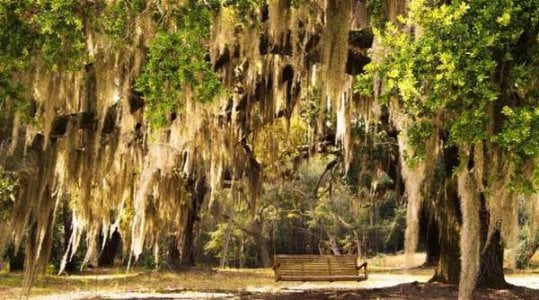Is this normal, or is it a looming threat? Here's how to spot this invasive plant in your garden
By
Danielle F.
- Replies 0
If you're a keen gardener or the type who likes strolling in public parks, it might be time to take a closer look at what's hanging from the trees.
A once-popular ornamental plant is causing a stir in some parts of Australia, and experts urged Aussies to check their gardens before this 'pretty' plant becomes a major pest.
Aussies may have spotted the Spanish Moss during a walk in a park before.
These plants (scientific name Tillandsia usneoides) look like lovely drapery from branches, evoking images of lush tropical gardens.
Native to the Americas, this plant is now sprawling thanks to Australia's warm, humid climate.
These conditions are perfect for spreading the plant's fluffy seeds.
However, don't be fooled by its silvery, trailing tendrils.
Experts call these plants epiphytes or plants that grow on other plants.
'It can infest dozens of native tree species. We've seen turpentines, brush boxes, lilly pillies and cheese trees all severely impacted,' Dr Carol Booth, the policy director at the Invasive Species Council, warned.
'Bush regenerators are raising the alarm as Spanish Moss spreads more widely,'
'It can infest dozens of native tree species, growing thickly, smothering trees, blocking sunlight, breaking branches, and sometimes even killing the host by preventing photosynthesis.'
Why is Spanish Moss a problem?
While Spanish Moss does not root in the soil or directly suck nutrients from its host, it could overwhelm trees by forming dense mats that block sunlight and trap moisture.
This could lead to broken branches, stunted growth, and, in severe cases, the death of a tree.
Local councils have since taken action after the warning.
Willoughby City Council recently warned residents that Spanish Moss is 'becoming a problem' and urged everyone to remove it from their plants if found.
Lane Cove Council echoed the sentiment, highlighting the threat to critically endangered local forests like the Sydney Turpentine-Ironbark Forest and Blue Gum High Forest.
Spanish Moss is a classic case of a garden escapee gone rogue.
It spreads easily via wind-borne seeds, fragments carried by birds, or its seeds clinging into everyday items like clothing or gardening tools.
Once it's in the landscape, it's tough to contain.
Yet, despite being invasive, Spanish Moss is still sold legally in Australia.
Dr Booth pointed out that it's not declared a noxious weed under any laws, making its regulation tricky.
Garden plants gone wild
Apart from the Spanish Moss, ornamental plants like the gazania also cause headaches for land care groups and farmers.
More than 30,000 plant species have been imported for gardening, but only a fraction have been assessed for their weed risk.
Some of the worst invaders, such as lantanas and blackberries, were once beloved garden additions.
The Invasive Species Council has since called for stricter regulations on the nursery industry to prevent a weed disaster.
With over $5 billion in annual losses attributed to invasive plants, it's a problem that affects us all.
If you spot a Spanish Moss in your garden, it's best to remove it by hand.
While herbicides work well against invasive plants, they could also harm the host tree.
However, things could get tricky if it's high up in a tree, so contact your local council for help with removal.
If you're planning to add new plants to your garden, do a quick check to see if they're invasive.
Your local council or land care group can provide advice on safe, native alternatives that will keep your garden beautiful and Australia's bushlands safe.

Have you spotted Spanish Moss or another runaway plant in your backyard? Have you battled an invasive species before? We would love to hear your stories and tips for maintaining a garden in the comments below!
MORE HERE: Are you missing this dangerous biosecurity threat hiding in plain sight?
A once-popular ornamental plant is causing a stir in some parts of Australia, and experts urged Aussies to check their gardens before this 'pretty' plant becomes a major pest.
Aussies may have spotted the Spanish Moss during a walk in a park before.
These plants (scientific name Tillandsia usneoides) look like lovely drapery from branches, evoking images of lush tropical gardens.
Native to the Americas, this plant is now sprawling thanks to Australia's warm, humid climate.
These conditions are perfect for spreading the plant's fluffy seeds.
However, don't be fooled by its silvery, trailing tendrils.
Experts call these plants epiphytes or plants that grow on other plants.
'It can infest dozens of native tree species. We've seen turpentines, brush boxes, lilly pillies and cheese trees all severely impacted,' Dr Carol Booth, the policy director at the Invasive Species Council, warned.
'Bush regenerators are raising the alarm as Spanish Moss spreads more widely,'
'It can infest dozens of native tree species, growing thickly, smothering trees, blocking sunlight, breaking branches, and sometimes even killing the host by preventing photosynthesis.'
Why is Spanish Moss a problem?
While Spanish Moss does not root in the soil or directly suck nutrients from its host, it could overwhelm trees by forming dense mats that block sunlight and trap moisture.
This could lead to broken branches, stunted growth, and, in severe cases, the death of a tree.
Local councils have since taken action after the warning.
Willoughby City Council recently warned residents that Spanish Moss is 'becoming a problem' and urged everyone to remove it from their plants if found.
Lane Cove Council echoed the sentiment, highlighting the threat to critically endangered local forests like the Sydney Turpentine-Ironbark Forest and Blue Gum High Forest.
Spanish Moss is a classic case of a garden escapee gone rogue.
It spreads easily via wind-borne seeds, fragments carried by birds, or its seeds clinging into everyday items like clothing or gardening tools.
Once it's in the landscape, it's tough to contain.
Yet, despite being invasive, Spanish Moss is still sold legally in Australia.
Dr Booth pointed out that it's not declared a noxious weed under any laws, making its regulation tricky.
Garden plants gone wild
Apart from the Spanish Moss, ornamental plants like the gazania also cause headaches for land care groups and farmers.
More than 30,000 plant species have been imported for gardening, but only a fraction have been assessed for their weed risk.
Some of the worst invaders, such as lantanas and blackberries, were once beloved garden additions.
The Invasive Species Council has since called for stricter regulations on the nursery industry to prevent a weed disaster.
With over $5 billion in annual losses attributed to invasive plants, it's a problem that affects us all.
If you spot a Spanish Moss in your garden, it's best to remove it by hand.
While herbicides work well against invasive plants, they could also harm the host tree.
However, things could get tricky if it's high up in a tree, so contact your local council for help with removal.
If you're planning to add new plants to your garden, do a quick check to see if they're invasive.
Your local council or land care group can provide advice on safe, native alternatives that will keep your garden beautiful and Australia's bushlands safe.
Key Takeaways
- Aussies were urged to check their backyards for Spanish Moss, an invasive plant spreading rapidly across Sydney.
- Spanish Moss, which grows on and smothers trees, poses a serious threat to native species and endangered forests.
- Despite the environmental risks, Spanish Moss and other invasive garden plants are still commonly sold in nurseries across Australia, prompting calls for stricter regulations.
- Escaped ornamental plants like Spanish Moss have become a major source of new environmental weeds, costing Australia over $5 billion in losses annually and threatening local ecosystems.
MORE HERE: Are you missing this dangerous biosecurity threat hiding in plain sight?







